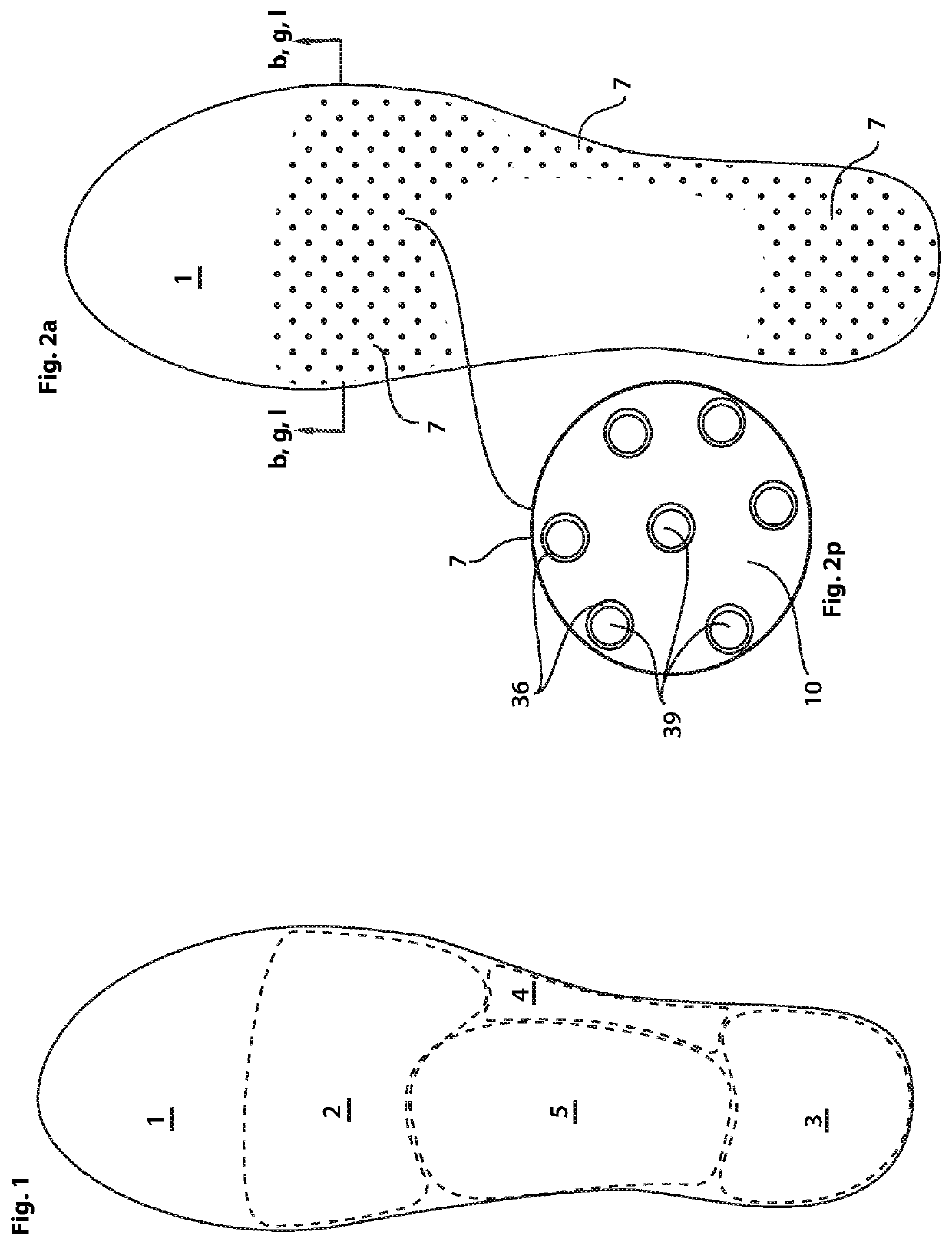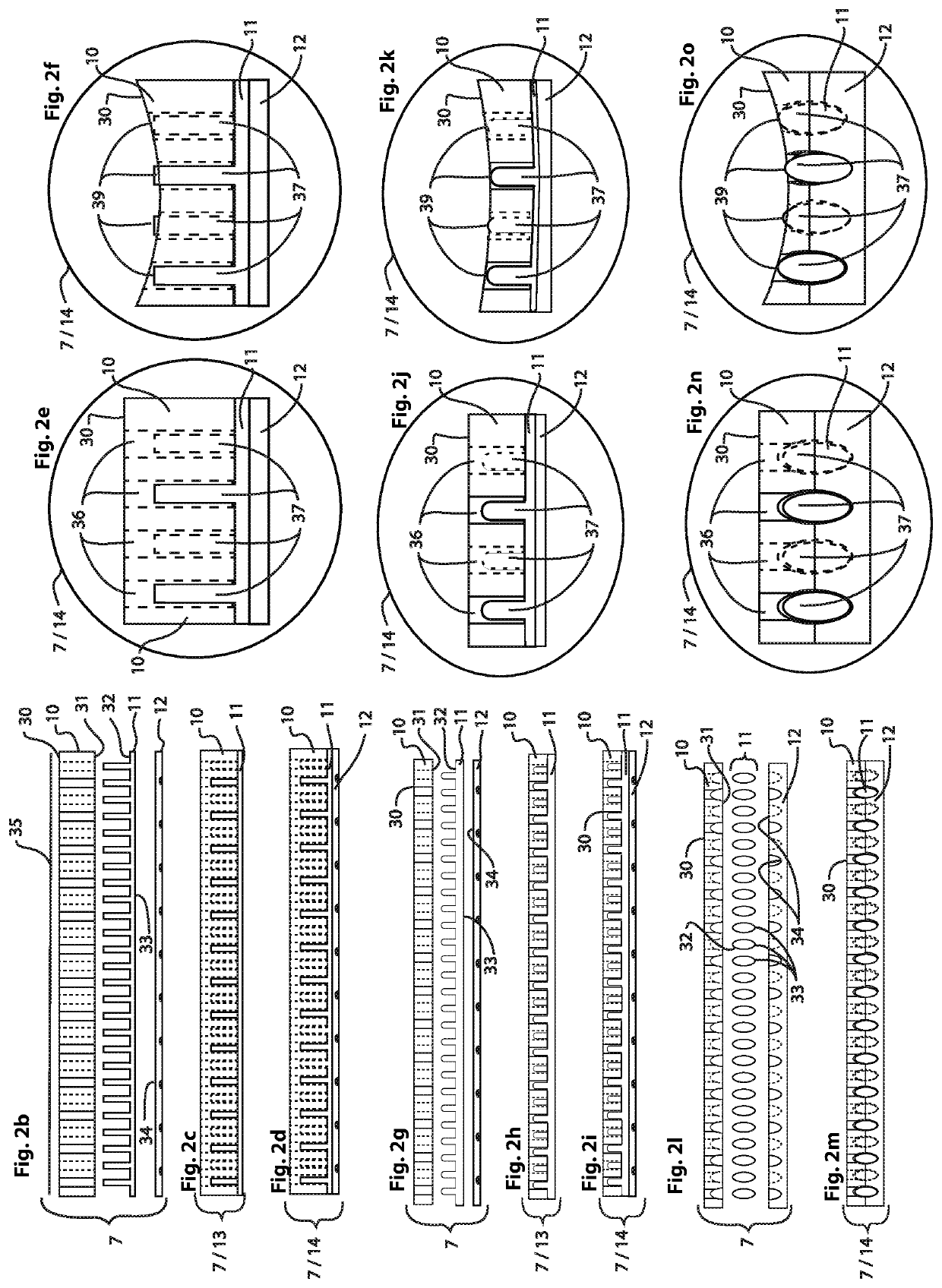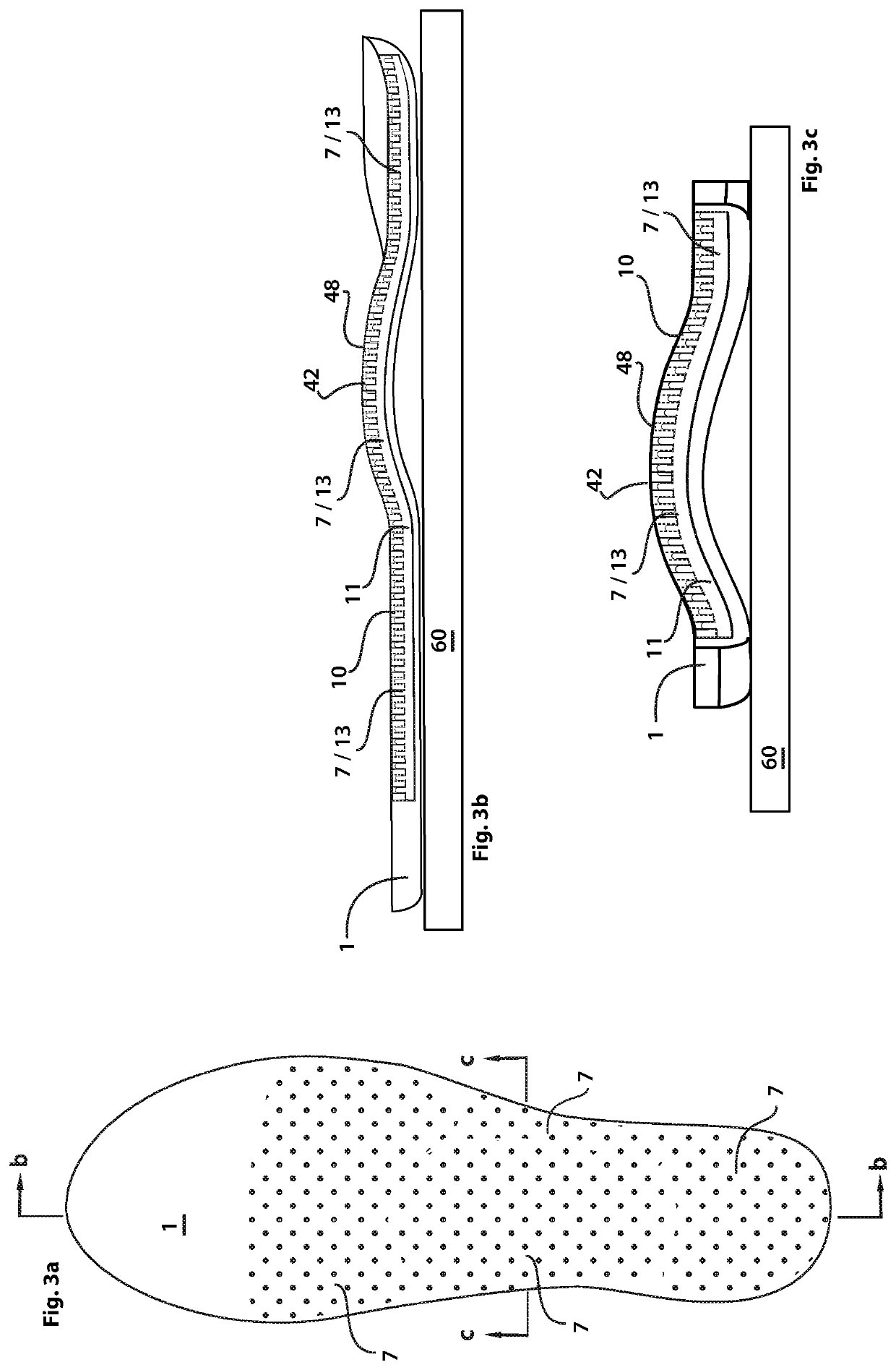Over the past one hundred years it has been commonly theorized that the feet are inherently weak and incapable of safely managing the gait-related stresses and shock forces naturally generated as people go about their daily lives especially during
high intensity activities.
However, virtually all conventional footwear, and all of these types of devices, interfere with or inhibit healthy natural neuro-musculoskeletal function throughout the lower limbs, hips, and back in some way, as described below.
Researchers have also shown a direct relationship between foot-related problems and footwear use with some researchers stating that footwear actually causes the problems.
In actuality, the feet are not inherently weak and incapable of safely managing the naturally generated gait-related forces.
More significantly, the habitual use of conventional footwear has simply trained the foot, leg, hip, and back neuromuscular systems to function poorly over time.
To date, virtually all of those skilled in the art of footwear, insole, and orthotic design and manufacture have not only failed to fully understand the complexity of the
human body's gait-related systems, by focusing on addressing what they perceive as a inherently “weak”, they have failed to contemplate or comprehend how their inventions and designs negatively
impact the neuro-musculoskeletal gait-related systems as a whole.
However, when it comes to neural
adaptation, a person has no conscious control over it.
That is, regardless, of
genetic predisposition, each individual's daily activities can cause, contribute to, or exacerbate poor / inefficient gait-related neuro-musculoskeletal function.
Regular (i.e., everyday) activities or movements that facilitate poor / inefficient gait-related neuro-musculoskeletal function result in maladaptive neuromuscular (proprioceptive) conditioning (i.e., poor technique) which progressively decreases the gait-related neuro-musculoskeletal systems functional capabilities (i.e., weakens) and increases risk of injury (i.e, promotes degenerative stress).
In this situation, stressors created during functional use exceed those of the “
sweet spot”, as the gait-related neuro-musculoskeletal systems are pushed beyond their “safe” or healthy tolerances, resulting in the degenerative stresses that cause, contribute to, or exacerbate systematic breakdowns and
disease.
The body's natural reflexive (“protect itself”) gait-related neuromuscular adaptations that the
lower limb, hip and back neuro-musculoskeletal systems utilize to compensate for the mechanical inefficiency often lead to an imbalance of strength /
weakness and flexibility / inflexibility (in opposing
muscle groups) and stiffness / pain at the joints or in the muscles, often, long after the actual
stressor has passed.
Even though people have different capabilities for accommodating stress, each person ultimately has a
breaking point.
This dissipates both the intensity and the degree of randomly localized stimulation to the sole of the foot which, with repetition, results in habituated maladaptive neuromuscular function.
Conversely, trauma and compensatory maladapted neuromuscular function can occur, when load-bearing forces are repetitively focused at one small location or a few small locations on the sole of the foot within the primary load-bearing areas.
When habitually
barefoot the
skin under the secondary load-bearing area is less thick, less robust, and more sensitive compared to the primary load-bearing points.
Repetitively unvaried and uniformly focused stimulus to the secondary load-bearing area results in habituated maladaptive neuromuscular function.
The sole of the foot's arch area is also the least capable of directly bearing loads generated during higher intensity gait-related activities.
Repetitively unvaried and uniformly focused stimulus to the sole of the foot's arch area results in habituated maladaptive neuromuscular function.
When walking or running, while wearing conventional footwear (which is the norm),
sensory input to the sole of the feet is both dampened due to force dissipation and unvaried in location, and the natural dynamic movements related to the neuro-musculoskeletal protective
reflex activated dome-like arches are restricted.
As a result, the feet and the
lower limb neuro-musculoskeletal systems do not receive the random varied
sensory input and exercise (movement) they require to stay healthy, robust, and strong.
This discrepancy in incidence can be directly attributed to footwear and the apparent faults in the design of footwear.
However, the supposedly more modern footwear designs, with their thicker and / or stiffer soles, restrictive uppers,
cushioning and supportive properties, are now the conventional norm.
Over time, the musculoskeletal
mechanics throughout feet, legs, hips, and back become increasingly dependent upon the supportive and
cushioning devices while losing their inherent robustness (i.e., become weaker).
This maladaptation is the leading cause of most foot-related problems.
Recent research indicates that while these products may provide some temporary relief of symptoms they do not “correct” the problem and they do nothing to encourage appropriate neuro-musculoskeletal function.
In addition, recent studies have shown that users of these products suffer more foot-related injuries than those who use nothing at all in their shoes.
As a result:a. the
lower limb neuro-muscular systems do not receive the appropriate varied stimulus (multiple random locations and intensities) needed to trigger the activity appropriate protective
reflex activations (nociceptive and proprioceptive related stimulus is dampened and or inhibited);b. the feet and lower limb become mechanically unstable due to inefficient musculoskeletal alignment and function, (i.e., insufficient height of reflex activated dome-like arch apices);c. dynamic force management and propulsion capabilities are compromised throughout the lower limbs, hips, and back; andd. maladaptive neuro-musculoskeletal function becomes conditioned (habituated).2. By restricting the natural movement of the feet.
If the great
toe is prevented from rising, the Keystone (apex) of the dome-like arches cannot stabilize.
If the Keystone (apex) of the dome-like arches is prevented from rising to the height required to manage the load-bearing forces, the dome-like arches will become unstable and lose their
mechanical load-bearing integrity. The upper construction of a shoe with a shallow
toe box and / or restrictions over the arch area (due to design, construction method, stiff materials and or tight lacing) restricts the dynamic raising of the apex of the dome-like arches and acts like a cast or splint on the feet, resulting in:a. the feet and lower limb becoming mechanically unstable due to inefficiently aligned bones, (i.e., insufficient height of reflex activated dome-like arch apices to mechanically manage loads—the foot over pronates as the arch flattens);b. foot and
ankle joint stiffness and
muscle atrophy;c. compromised dynamic force management and propulsion capabilities;d. inhibited nociceptive and proprioceptive reflex
muscle activity; ande. maladaptive neuro-musculoskeletal function through out lower limbs, hips, and back.3. By artificially supporting the soles of the feet.
However, while these devices may provide some temporary relief:a. they result in a greater sole of the
foot surface area bearing the load-bearing forces,b. they create a less variable and more dampened load-bearing sensory stimulus [the lower limb neuromuscular systems do not receive the appropriate varied stimulus (at multiple random locations and intensities) needed to trigger the activity-appropriate protective reflex activations (nociceptive and proprioceptive related stimulus is dampened and or inhibited)];c. with prolonged use, the feet and lower limb become progressively weaker (
atrophy) and increasingly dependent upon the artificial support, due to the fact that they are not challenged to manage the load-bearing forces;d. with prolonged use, foot and
ankle joint stiffens, and muscles
atrophy, due to the loss or restriction of dynamic movement;e. they compromise dynamic force management and propulsion capabilities; andf. they promote maladaptive neuro-musculoskeletal function throughout the entire lower limb, hips, and back.4. By incorporating rigid
orthotics, insoles, midsoles, and / or outsol
In all instances, maladaptive neuro-musculoskeletal function and damaging degenerative stresses increase relative to the habitual use of footwear, insole or
orthotics that incorporate
cushioning, restrictive, supportive, and stiffness properties.
When this occurs, the feet and lower limb are incapable of effectively responding to the ever-changing environmental forces (i.e., become mechanically weaker).
However, the stimulus produced by any given product may, or may not, produce the randomized variable stimulus required for healthy optimal neuro-musculoskeletal function and such stimulus may in fact cause maladaptive neuro-musculoskeletal function.
It has been observed, by those skilled in the art of therapeutic insole application, and those having familiarity with the usage of products as disclosed in U.S.
Patent Application Publication No. 20130318818 A1 that while the devices provide some benefit, they fail to provide the optimal randomly varied stimulus required to trigger an adequate multidimensional gait-related neuro-musculoskeletal protective reflex response because the shoe midsole's or insole's upwardly extending dome upper surface always centralizes the stimulus created by a respective
biofeedback catalyst at one location (the apex of the foot's arch systems).
In addition, the device's upwardly extending dome upper surface causes a progressive dissipation of the load-bearing forces and related stimulus to the sole of the foot by spreading the forces uniformly over the
plantar surface area of the foot that engages with the dome's upper surface.
Furthermore, different stimulus intensities can only be created by interchanging a respective
biofeedback catalyst with another comprised of different geometries or material densities.
However, is has been found that the device disclosed in U.S. Pat. No. 5,404,659 does not function as described, and that the majority of users find the device too uncomfortable.
In particular, the stimulus created is static, too intense, and limited to one centralized location.
The type of stimulus created by this device is clearly not beneficial to the user as it causes maladaptive stress inducing neuromuscular responses that cause pain, discomfort, and
possible injury to the user.
However, it has been observed, by those skilled in the art of therapeutic insole application and those having familiarity with the usage of products as disclosed in U.S. Pat. Nos. 6,301,807 B1 and 6,732,457 B2 and U.S. Pat. No. 7,100,307 B2, that while these products provide some benefit, they neither optimally catalyze
muscle group balancing nor do they adequately catalyze the gait-related neuro-musculoskeletal reflex responses that are required to optimally stabilize the musculoskeletal alignment throughout the feet, legs, hips, and back during multidimensional activities; such that the activity-related musculoskeletal alignment is the most efficiently capable of managing those the forces generated from the perspectives of
injury prevention, comfort, and
performance enhancement.
However, it has been observed, by those skilled in the art of therapeutic insole application and those having familiarity with the usage of products as disclosed in U.S.
Patent Application Publication No. 20130312280 A1, in U.S.
Patent Application Publication No. 20130318818 A1, U.S. Pat. No. 5,404,659, in U.S. Pat. No. 6,301,807, in U.S. Pat. No. 6,732,547, and in U.S. Pat. No. 7,100,307 that the described target area (the point of articulation of the lateral cuneiform, cuboid, and navicular bones of the foot) is not the preferred or optimal target area and that when stimulus is repeatedly centralized at this area, or any one area, the neuro-muscular systems will become habituated to the stimulus and tune it out.
The wearer of the devices, as disclosed, can only counter the
habituation effect caused by repetitively stimulating the target area by progressively employing firmer catalyst and less resilient inserts as a means of increasing the stimulus intensity at the target area.
However, over time, the neuro-muscular systems become habituated to every increase in stimulus intensity created by the progressively firmer catalyst inserts, to the point where the catalysts become arch supporting mechanisms, the insert stimulus becomes painful, or the forces created become harmful and
cause injury to the user.
Therefore, the described dome-shaped catalysts' fixed apex location on the inner sole or shoe midsole, are unable to provide (without modification) the subtle random stimulus locations and intensity variations during each step and from one step to another that are required to achieve optimal gait-related neuro-musculoskeletal protective reflex responses during multidirectional activities.
Therefore, the device as disclosed fails to provide the optimal varied stimulus intensities required to trigger an adequate multidimensional gait-related neuro-musculoskeletal protective reflex response.
However, it has been found that the massaging action provided by the device disclosed in U.S. Pat. No. 4,674,203 A fails to provide the optimal varied stimulus required to trigger an adequate multidimensional gait-related neuro-musculoskeletal protective reflex response.
However, it has been found that the massaging action provided by the device disclosed in U.S. Pat. No. 4,760,655 A fails to provide the optimal varied stimulus required to trigger an adequate multidimensional gait-related neuro-musculoskeletal protective reflex response.
Furthermore, the multiplicity and dimensional uniformity of the beads cover the total surface area of the insole device, which cause the load-bearing forces and related stimulus intensities at the sole of the foot to dissipate as the forces are uniformly spread over an enlarging sole-of-the-
foot surface area.
Therefore, the device disclosed fails to provide the optimal varied stimulus intensities required to trigger an adequate multidimensional gait-related neuro-musculoskeletal protective reflex response.
However, it has been found that the messaging action provided by the device disclosed in U.S. Pat. No. 4,841,647 A fails to provide the optimal varied stimulus required to trigger an adequate multidimensional gait-related neuro-musculoskeletal protective reflex response.
Therefore, the device disclosed fails to provide the optimal varied stimulus intensities required to trigger an adequate multidimensional gait-related neuro-musculoskeletal protective reflex response.
However, it has been observed by those skilled in the art of therapeutic insole application and those having familiarity with neuro-musculoskeletal function and with the usage of products disclosed in U.S. Pat. No. 5,664,342 A fail to provide the optimal varied stimulus required to trigger an adequate multidimensional gait-related neuro-musculoskeletal protective reflex response.
However, it has been observed by those skilled in the art of therapeutic insole application and those having familiarity with neuro-musculoskeletal function and with the usage of products disclosed in U.S. Pat. No. 6,082,024 A fail to provide the optimal varied stimulus required to trigger an adequate multidimensional gait-related neuro-musculoskeletal protective reflex response.
The said device's specifically located pressure-stimulation elements engage and
massage the sole of wearer's foot at fixed nerve center locations and such locations are not relevant to gait-related neuro-musculoskeletal protective reflex activations.
However, it has been found that the stimulus provided by the devices disclosed in U.S. Pat. No. 7,765,719 fail to provide the optimal varied stimulus required to trigger an adequate multidimensional gait-related neuro-musculoskeletal protective reflex response because the stimulus is always fixed or centralized on one half of the
plantar surface of the sole of the foot.
However, it has been found that the messaging action provided by the device disclosed in U.S. Pat. No. 8,615,905 B1 fails to provide the optimal varied stimulus required to trigger an adequate multidimensional gait-related neuro-musculoskeletal protective reflex response.
 Login to View More
Login to View More 


